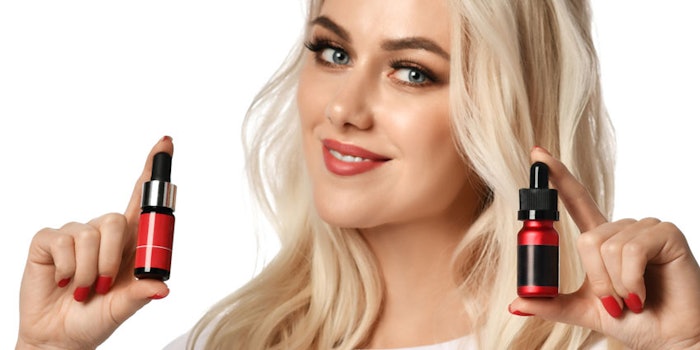
According to a recent P&G patent, the formulation of stable black and colored inks for application to white substrates is well-understood. For potential cosmetic application, however, dye-based inks exhibit low opacity because they are transparent by nature. Also, pigmented-based black inks use particle sizes that are small enough for suspending (< 50 nm) but these are too small to scatter visible light.
For opacity—which is key to color cosmetic coverage—optimal light scattering occurs at half the wavelength of light, the patent reports, and the visible light spectrum ranges from ~400 nm to ~700 nm. Thus, the optimal particle size for opacification is from ~200 nm to ~350 nm. However, formulating an opaque stable cosmetic ink that can be jetted at these particle sizes is difficult due to the levels required to achieve opacity and in consideration of gravitational settling.
See related: L'Oreal Beta Launches YSL Rouge Sur Mesure Powered by Perso
Usage Considerations
Furthermore, the inventors noted cosmetic inks should be durable on a broad range of skin types and remain in place in order to effectively cover skin imperfections. This is challenging because the surface properties of skin vary within individuals and from person to person; for example, the contact angle of water on a person's cheek can vary from 0-110 degrees due to differing levels of sebum. As such, cosmetic inks will spread differently, dry at different rates, have varying durability and provide varying coverage.
See related: 1HQ Proposed Digital Lipstick for Smart Personalization
The focus of this invention was therefore to create a cosmetic ink composed of particles that can provide opacity and having a surface tension that will increase wettability and decrease drying time on skin; all while remaining stable.
Cosmetic Ink Comprising a Surface Tension Modifier
U.S. Pat Application 20210030637
Date: Feb. 4, 2021
Assignee: The Procter & Gamble Company
Disclosed in the resulting patent is a cosmetic ink comprising: a) from ~1% to 45% active wt of a particulate material having a size distribution (D50) of ~100 nm to ~2,000 nm; b) a rheology modifier selected from an alkali swellable emulsion polymer, a hydrophobically modified alkali swellable emulsion polymer and combinations thereof; c) a polymeric dispersant; and d) a surface tension modifier selected from C1-C16 alcohols, C5-C18 diols and mixtures thereof.
Also described is a cosmetic ink comprising: a) from ~1% to 45% active wt of a particulate material; b) > 0.30% active wt of a rheology modifier selected from a (meth)acrylate polymer, a (meth)acrylate copolymer and mixtures thereof; c) from ~0.01% to ~1.00% active wt of a polymeric dispersant; d) from ~0.1% to ~5.0% active wt of a surface tension modifier selected from C1-C16 alcohols, C5-C18 diols and mixtures thereof; and e) from ~10% to ~30% active wt of a humectant.
See related: CES 2021 Beauty Innovations Unveiled
In a last iteration, a cosmetic ink is described consisting of: a) a particulate material comprising titanium dioxide; b) a rheology modifier selected from a (meth)acrylate polymer, a (meth)acrylate copolymer and mixtures thereof; c) a polymeric dispersant; and d) from ~0.1% to ~5.0% active wt of a surface tension modifier selected from C1-C16 alcohols, C5-C18 diols and mixtures thereof.
Additional details are disclosed in the full patent, which was accessed on Feb. 15, 2021.









